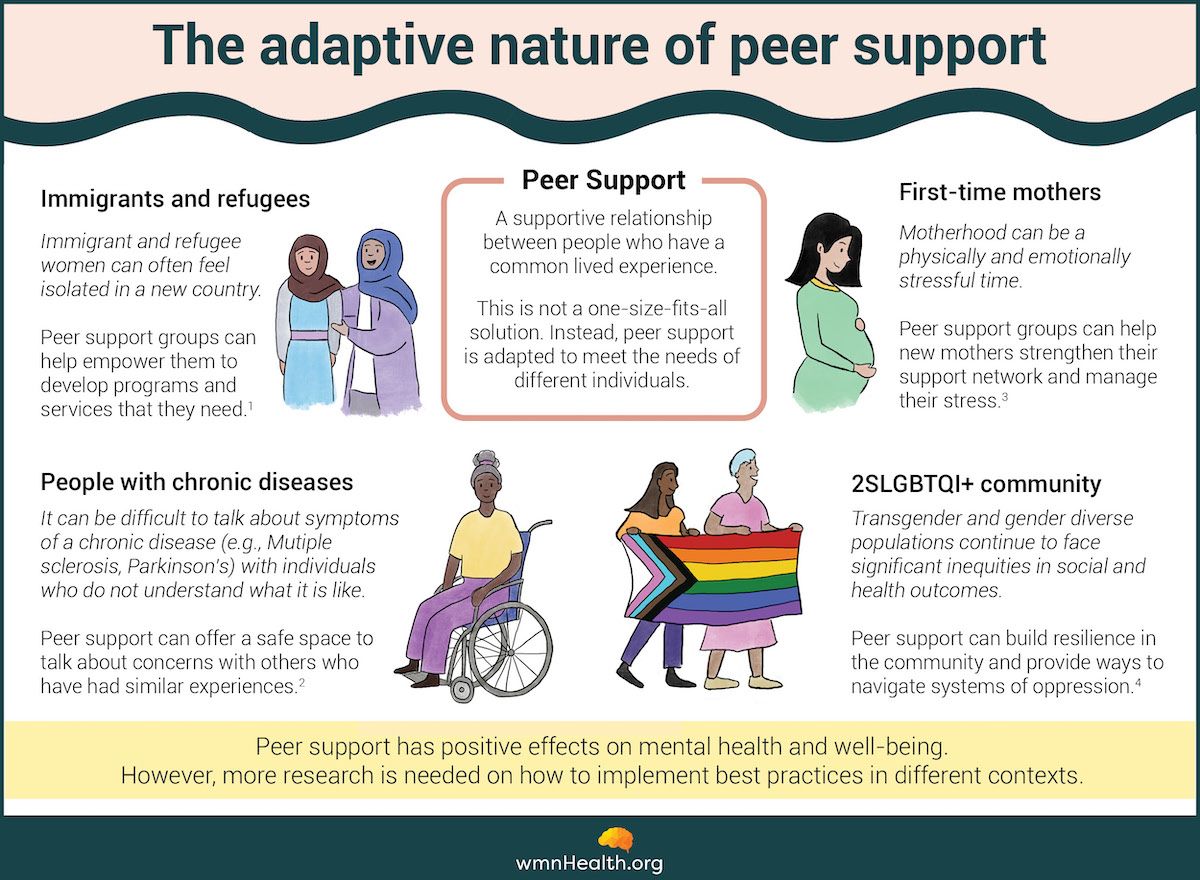
This article covers:
- What is peer support, and how is it used?
- What is the history of peer support?
- Peer support for mental health in the Black community
- What are the benefits and limitations of peer support?
- How can you make the most of peer support?
What In 2005, Valeria Chambers created Black Voices: Pathways 4 Recovery, a peer support group for people of the African diaspora living in Roxbury, Massachusetts. This historic neighborhood is the heart of Black culture in Boston.
Chambers was one of the first people in Massachusetts to become a certified peer specialist, a person who is trained to share their experiences of healing with trauma, a mental health diagnosis, services, and support with others. Black Voices was a response to the need she saw for a safe space where people could talk about mental health, substance use, recovery, and "living Black in America."
"In the Black community, there's a propensity to keep just moving along," Chambers says. "The emotional scars, things going on in the home, the stress and pain that people are enduring, all gets swept into the back room."
Pre-pandemic, a typical Black Voices meeting would bring together 100 people — young people, elders, caregivers, providers, many Black women — for a peer-led community discussion about mental health.
The organization has evolved over the years and through the pandemic. Still, its goal remains the same: To increase access to trauma-informed, culturally competent mental health care for Black people in Massachusetts. Peer support — any organized support provided by and for people with mental health problems or illnesses — is one way to achieve that.
In North America and internationally, peer support services are gaining traction at a time when demand for health services is far outpacing supply, barriers to access are high, and the treatment needs of BIPOC and other historically marginalized groups aren't always met, especially people with lived experience of mental illness and substance use, survivors of gender-based violence, and trans youth.
21 % of Black and African Americans reported having a mental illness, compared to 23.9% of non-Hispanic Whites. However, just 39% of Black and African Americans received mental health services compared to non-Hispanic Whites (52%).
Peer support advocates argue it is economical, personal, and practical compared with clinical care. There is also good evidence that peer support services are as effective as those delivered by non-peer professionals. Still, the availability of peer support varies across the United States and Canada, and implementation challenges persist.
So, what are the basics of peer support? How can it factor into recovery? What does it have to offer, and what are its limitations? And what should people know before turning to peer support?
 Infographic by Cat Lau. References below.
Infographic by Cat Lau. References below.What is peer support, and how is it used?
Peer support is as old as humans. But its contemporary origins lie in the mutual aid societies of the 18th and 19th centuries. Established in Europe and North America by groups of individuals facing common challenges, such as workers, immigrants, or people with specific health conditions, mutual aid societies provided emotional and financial support to their members.
In the 20th century, movements such as Alcoholics Anonymous (AA), known for its 12-step model, gained prominence and served as a template for peer-led recovery programs. Then, later, in the 1970s, came the rise of the consumer mental health movement — a driving force behind peer support. At the time, large government mental institutions were closing down. Former patients, seeking autonomy, better services, and fundamental human rights, embraced new models of care.
Since then, the peer support model has become increasingly integrated into health systems worldwide. It has also been applied to a broad range of chronic conditions like heart disease and cancer, Parkinson's and multiple sclerosis, and to maternal and child health, including breastfeeding and post-partum depression. There are also peer support groups focused on: immigrant and migrant experiences; domestic violence; body image; eating disorders; race, racism, and identity; gender identity and expression; sexual health; victims of gang violence; and, grief.
Peer support refers to a relationship between individuals with similar lived experiences, such as shared mental health challenges or other common life circumstances, and who provide one another with emotional, social, or informational support.
Peer Support
Any organized support provided by and for people with mental health problems or illnesses.
Peer support is sometimes known as self-help, mutual aid, co-counselling or mutual support. These terms are all used for processes that bring people with shared experiences together in various structures: in groups, organizations, online and one-to-one.
Source: Peer Support Canada
It involves listening, sharing wisdom, strength and hope, and helping others tap into their unique strengths to heal. Peer support isn't a treatment but a recovery model.
"The whole purpose of peer support is to have a mutual relationship where people relate to one another in a give-and-take fashion. Actively listening, learning, and supporting one another," says Chambers. "The concept of having someone to walk alongside you and knowing you are not alone is so powerful."
Peer support can take many forms, including peer-led workshops, helplines staffed by trained peer supporters, and informal meetings between two individuals or a group of people with shared experiences.
Workplaces, schools, churches, and healthcare organizations are common peer-support settings. But over the years, Black Voices has held meetings in coffee shops and parks in the Boston area. (It also went virtual during the pandemic.) The choice of settings was deliberate because "many people in the community have had horrendous experiences with clinicians and feel very hurt by the medical system," Chambers says.
This is just one of the ways Chambers and her fellow researchers are adapting peer-led recovery programs to address aspects of shared identity like race, ethnicity, and culture that are often overlooked.
Black Voices, now state-wide, is informed by research conducted in partnership with the Black community.
"That was a really important step – the idea that people could have more of a say in what supports them and feels good to them," says Chambers, who is a senior researcher with the Health Equity Lab, an interdisciplinary group of researchers, clinicians, and community partners, at Cambridge Health Alliance/Harvard Medical School.
"Over and over, we've found people want to learn, grow, and heal with one another. They want to be engaged in a mutual give-and-take without judgment or hierarchy from which to fear further trauma. And they seek a process where their opinions, voices, and experiences are not just taken into account but are centered, valued, and respected," Chambers wrote in a Harvard Health blog post about Black Voices.
Peer Support: What are its benefits and limitations?
It is crucial to consider the strengths and limitations of peer support when accessing such services.
Researchers have studied peer support's impact on people transitioning from receiving peer support to being a peer supporter. They found it has profound benefits, especially for those with serious mental illness. Sharing one's lived experience can cause a dramatic shift in a person's identity, transforming them from being viewed — and viewing themselves — as a victim to someone with hope and opportunities ahead.
Chambers has experienced and witnessed that transformation firsthand among the certified peer specialists.
"One thing that helped the most is seeing others coming out the other side, knowing they were not alone, they were not broke, they were not to be feared. They could also see that it was possible to live after diagnosis: Live to have a family, to work, to go to school. And, even those who are not able to do that have found meaning in doing advocacy," says Chambers.
But what is the impact of peer support on recipients? Are interventions provided by peers as effective as those offered by non-peers? And what aspects of peer support are most important?
Studies and anecdotal evidence suggest that peer support services are as effective as services provided by non-peers. They can lead to positive outcomes for mental health, including improved engagement and well-being, increased feelings of empowerment, improved self-esteem, enhanced coping skills, reduced feelings of isolation, and a greater sense of hope and resilience.
A report by the Mental Health Commission of Canada also found peer support led to reduced hospitalization rates, isolation, and symptom distress, and lower costs for the healthcare sector.
However, not all peer support services are created equal. Their effectiveness can vary depending on factors such as group dynamics, the quality of facilitation, and the willingness of participants to engage actively.
Another factor is whether or not it is integrated with professional mental health services. A recent review article suggests that peer support may have the most significant impact when integrated into the healthcare system, where it extends care into the community.
While a growing body of research supports the effectiveness of peer support, more studies are needed to better understand the specific impacts and mechanisms of peer support for mental health and other chronic illnesses.
After nearly two decades leading Black Voices, Chambers says one thing about peer support is clear: "There is so much more strength in the group as compared to one individual."
How can you make the most of peer support?
Before turning to peer support for mental health, there are several important factors a person should keep in mind to get the most from the experience.
Here are 10 tips to maximize the benefits of peer support:
- View it as complementary care: Understand that peer support is not a substitute for professional mental health services. It complements but does not replace clinical care.
- Set clear expectations: Clarify your goals and expectations for participating in peer support. What do you hope to gain from the experience? Setting clear intentions can help you focus your efforts.
- Choose the right peer support group: Explore different options to find one that aligns with your specific needs and preferences. Consider the format (in-person, online), the focus (general mental health, specific condition), and the group's dynamics.
- Be open and honest: Peer support relies on open and honest communication. Sharing your experiences, challenges, and feelings with the group can lead to more meaningful support and connections.
- Practice active listening: Peer support is a two-way street. Be a good listener and offer support to others in the group. Active listening can foster a sense of community and mutual support.
- Be patient: Healing and personal growth take time. Don't rush your progress; be patient with yourself as you navigate your mental health journey.
- Stay committed and consistent: Consistency in attending peer support sessions can lead to more significant benefits over time. Make an effort to attend regularly and actively participate.
- Learn from others: Peer support offers an opportunity to learn from the experiences and coping strategies of others. Be open to new perspectives and insights that may help you.
- Practice self-care: Peer support can sometimes be emotionally taxing, so prioritize self-care. Engage in activities that promote your mental well-being, and don't hesitate to take breaks when needed.
- Please seek professional help when needed: While peer support can be valuable, it may not be sufficient for addressing severe or urgent mental health concerns. Contact a mental health professional or crisis hotline immediately if you are in crisis or struggling with severe symptoms.
Infographic references:
- "Immigrant Women’s Peer Support Program, Immigrant Services Society of BC." CAMH, https://www.camh.ca/en/
professionals/professionals-- projects/immigrant-and- refugee-mental-health-project/ newsletter/promising- practices/2022/pp-pg-feb-2022- --immigrant-women-peer- support-prgm-eng-and-fr Accessed 25 September 2023 - Louisa Ng, Bhasker Amatya, Fary Khan, "Outcomes of a Peer Support Program in Multiple Sclerosis in an Australian Community Cohort: A Prospective Study", Journal of Neurodegenerative Diseases, vol. 2013, Article ID 429171, 7 pages, 2013.
- Law KH, Jackson B, Tan XH, Teague S, Krause A, Putter K, Du'cane M, Gibson L, Bulles KF, Barkin J, Dimmock JA. Strengthening Peer Mentoring Relationships for New Mothers: A Qualitative Analysis. J Clin Med. 2022 Oct 12;11(20):6009. doi: 10.3390/jcm11206009. PMID: 36294330; PMCID: PMC9605247.
- Hannah Kia, K Kenney, Kinnon Ross MacKinnon, Alex Abramovich, Travis Salway, Olivier Ferlatte, Rod Knight, Grant Charles, Sheila K. Marshall, “It saves lives”: Peer support and resilience in transgender and gender diverse communities,
SSM - Qualitative Research in Health, Volume 3, 2023, 100264.


